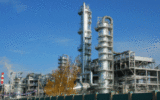Olefin petrochemicals suffer the fate of Iranian methanol producers

According to an exclusive report by Energy Press, the bitter tragedy of Iranian methanol producers is now on the verge of being repeated in olefin petrochemicals, where not only is the outlook for producing suitable feedstock bleak, but the consumer market has also become unstable, and the alarm bells have been sounded for one of the most important chains of Iran’s petrochemical industry, the “Western Ethylene Pipeline.”
Experts warn that if the current trend continues and production in the South Pars gas field naturally declines, the country’s gas production capacity will be halved from the current 800 million cubic meters by 2022. Such a reduction would mean a simultaneous reduction in all components of the gas flow, including ethane, which supplies the main feedstock for the country’s olefin units, especially the Western Ethylene Pipeline.
Warning about the future of the Western Ethylene Pipeline
In an interview with this media outlet, energy expert Hossein Mirafazli warned about the decline in ethane production capacity in the country, saying: According to official reports from the National Gas Company, if serious investment is not made to maintain production in South Pars, the country’s gas production will reach about 400 million cubic meters per day by 2023. This means that the production of ethane, propane and butane will also be reduced by half.
He emphasizes: Most of the ethane consuming units in the country are located in the South Pars and Assaluyeh regions. Kavian Petrochemical, which supplies the main feed to the Western Ethylene Pipeline, will be the most damaged. If the injection into this line is reduced, dozens of downstream units across the country will face a feed crisis and the threat of closure.
Solution: Construction of MTO units within the country
According to Mirafazli, the solution to this crisis is neither complicated nor far-fetched. He suggests that Iran do what China has been doing for years: convert methanol to olefins by building MTO units.
He says: “We produce methanol and sell it to China, and China converts it to ethylene. Meanwhile, by building MTO units domestically, both the problem of selling methanol will be solved and the feedstock for the western ethylene pipeline will be provided. This is a dual-purpose solution.
He explains: Each MTO unit with a capacity of 650,000 tons per year can produce about 650,000 tons of ethylene, 40-50,000 tons of propylene and a significant amount of pyrolysis gasoline. By building just four such units, 2.5 million tons of ethylene will be produced annually; equivalent to the entire needs of the country’s western ethylene pipeline.
An opportunity to get rid of crude sales and the unemployment crisis
Mirafazli also emphasizes that these projects can be operated within three years with an investment of 400 to 500 million dollars for each unit and if the private sector is properly managed. He says: The construction of these units will not only prevent the crude sales of methanol, but also save the current units such as Zagros, Marjan, Dena, Sabalan and Kaveh from the sales crisis.
The energy expert concludes: Let’s not forget the story of methanol; recklessness in development, lack of planning in feed and carelessness in the market. Let’s not let the same scenario be repeated in olefins.
Tags:petrochemicals
- Comments sent by you will be published after approval by site administrators.
- Comments that contain slander will not be published.
- Comments that are not in Persian or not related to the news will not be published.

Comments
Total comments : 3 Awaiting review : 3 Date: 0